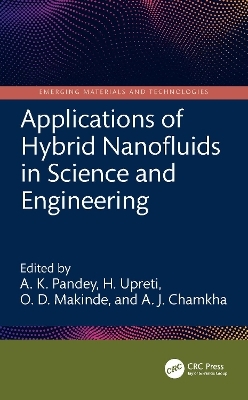
Applications of Hybrid Nanofluids in Science and Engineering
CRC Press (Verlag)
9781032535470 (ISBN)
Applications of Hybrid Nanofluids in Science and Engineering delves deep into the multifaceted realms in which these dynamic fluids are playing a pivotal role in various fields.
This comprehensive volume elucidates the diverse applications and promising potentials of hybrid nanofluids. It introduces hybrid nanofluids and their preparation methods, thermophysical properties, advantages, applications, and future scope. Models to compute the effective thermophysical properties of hybrid nanofluids are also discussed, along with their limitations. In the application section, mathematical models are formulated to contemplate the flow of hybrid nanofluids through different surfaces/geometries under different situations. Also, the entropy generation minimization in hybrid nanofluid flow is discussed with its application in refrigeration, power generation, and other processes.
The subject matter in this book will enable the reader to do the following:
Learn the ins and outs of hybrid nanofluids—from how they are made to the special characteristics they embody
Explore hybrid nanofluids' potential in thermal management, energy systems, materials science, biomedical engineering, and more
Use advanced computational and analytical methods to analyse complex fluid dynamics models
Anticipate the impact of hybrid nanofluid research on upcoming sectors like renewable energy and innovative manufacturing
This book is aimed at researchers and graduate students in mechanical and chemical engineering and materials science.
Alok Kumar Pandey is an Assistant Professor in the Department of Mathematics, Graphic Era (Deemed to be University), Dehradun, Uttarakhand, India. His area of research is Computational Fluid Dynamics. He is currently the Editor for the Journal of Engineering Researcher and Lecturer, Associate Editor for the Journal of Advanced Research in Numerical Heat Transfer and Journal of Advanced Research in Micro and Nano Engineering, and serving as a member of the editorial board for the journal Teknomekanik. Himanshu Upreti is an Assistant Professor in the School of Engineering and Technology, BML Munjal University, Gurugram, Haryana, India. His research interest includes topics from fluid dynamics, heat and mass transfer analysis. He is member of the Indian Society of Theoretical and Applied Mechanics (ISTAM) and National Society of Fluid Mechanics and Fluid Power (NSFMFP). Oluwole Daniel Makinde is a distinguished Professor of Applied Mathematics and Computation with over 26 years of experience in South African universities. He is affiliated with the Faculty of Military Science at Stellenbosch University, South Africa. Makinde has received several prestigious awards, including the 2011 African Union Kwame Nkrumah Continental Scientific Award, the 2009/2010 T.W. Kambule Senior Researcher Award, and the 2014 Nigerian National Honour Award (MFR). He is a fellow of multiple academies, including the African Academy of Sciences and the International Academy of Physical Sciences. Ali J. Chamkha is a Distinguished Professor of Mechanical Engineering and Dean of Engineering at Kuwait College of Science and Technology. He is currently the Editor-in-Chief for the Journal of Nanofluids and has served as an Editor, Associate Editor or a member of the editorial board for many journals such as ASME Journal of Thermal Science and Engineering Applications, International Journal of Numerical Method for Heat and Fluid Flow, Journal of Thermal Analysis and Calorimetry, Journal of Porous Media, and others. Professor Chamkha was included in the World’s Top 2% Scientists 2020, 2021, 2022, and 2023 (by Stanford University).
1 Introduction to Hybrid Nanofluids2 Empirical Correlations for the Estimation of Thermophysical, Friction Factor, and Heat Transfer Properties of Hybrid Nanofluids; 3 Synthetic Routes of Various Water-Based Hybrid Nanofluids and Their Thermal Conductivities; 4 Hybrid Nanofluid Heat Transfer in an Inclined Saturated Porous Cavity: An Experimental Study; 5 Effects of Different Shapes of the Porous Cavity on Natural Convective Heat Transfer of Hybrid Nanofluids: Experimental Study; 6 Hydrothermal Performance of Magnetized Al2O3-TiO2-Water Hybrid Nanofluid Flow within a Triangular Enclosure with a Circular Heater: A Multiple Linear Regression Analysis; 7 A Numerical Study of Micropolar Hybrid Nanofluid Flow over the Wedge with the Impacts of Hall and Ion Slip Using PINN; 8 Heat Diffusion in Non-Newtonian Magnetized Hybrid Blood Flow over a Wedge-Shaped Region; 9 Sensitivity Analysis in Hybridized Casson Nanofluid Near a Perforated Riga Plate; 10 Characteristic of Heat-Induced Ferrofluid Flow on a Riga Sensor Plate with the Effect of Viscous Dissipation; 11 Impact of Thermal Radiation on Electrically Conducting Hybrid Nanofluid Flow through an Expanding/Contracting Wedge Surface with Heat Generation; 12 Mixed Convection of Variable Viscosity Hybrid Nanofluid within Two Inclined Concentric Pipes; 13 Computational Study of Heat Transfer in Sisko Hybrid Nanofluid Flowing over a Radially Stretching Disc; 14 Influence of Slip Mechanisms and Suction on Hybrid Nanofluid Flow via a Stretching Cylinder with Heat Generation; 15 Study on Effects of Uncertain Volume Fraction on Hybrid Nanofluid Flow Using the Homotopy Analysis Method; 16 Marangoni Boundary Layer Flow of an Electrically Conducting Hybrid Nanofluid for the Impact of Particle Shape and Thermal Radiation; 17 Legendre Wavelet Collocation Approach to Simulate Hybrid Nanofluid Flow with Ohmic Heating and Viscous Dissipation under Magnetic Field; 18 Numerical Study of Magnetized Hybrid Nanofluid Flow over a Stretching Sheet
| Erscheinungsdatum | 29.01.2025 |
|---|---|
| Reihe/Serie | Emerging Materials and Technologies |
| Zusatzinfo | 71 Tables, black and white; 217 Line drawings, black and white; 15 Halftones, black and white; 232 Illustrations, black and white |
| Verlagsort | London |
| Sprache | englisch |
| Maße | 156 x 234 mm |
| Gewicht | 880 g |
| Themenwelt | Naturwissenschaften ► Physik / Astronomie ► Strömungsmechanik |
| Technik ► Maschinenbau | |
| ISBN-13 | 9781032535470 / 9781032535470 |
| Zustand | Neuware |
| Informationen gemäß Produktsicherheitsverordnung (GPSR) | |
| Haben Sie eine Frage zum Produkt? |
aus dem Bereich


